+ Open data
Open data
- Basic information
Basic information
| Entry | Database: PDB / ID: 2vkx | ||||||
|---|---|---|---|---|---|---|---|
| Title | Human NCAM, FN3 domains 1 and 2, M610R mutant | ||||||
 Components Components | NEURAL CELL ADHESION MOLECULE | ||||||
 Keywords Keywords | CELL ADHESION / ADHESION RECEPTOR | ||||||
| Function / homology |  Function and homology information Function and homology informationregulation of semaphorin-plexin signaling pathway / commissural neuron axon guidance / NCAM1 interactions / epithelial to mesenchymal transition / ECM proteoglycans / NCAM signaling for neurite out-growth / Signal transduction by L1 / Interferon gamma signaling / : / virus receptor activity ...regulation of semaphorin-plexin signaling pathway / commissural neuron axon guidance / NCAM1 interactions / epithelial to mesenchymal transition / ECM proteoglycans / NCAM signaling for neurite out-growth / Signal transduction by L1 / Interferon gamma signaling / : / virus receptor activity / RAF/MAP kinase cascade / cell adhesion / neuron projection / Golgi membrane / external side of plasma membrane / cell surface / extracellular region / membrane / plasma membrane / cytosol Similarity search - Function | ||||||
| Biological species |  HOMO SAPIENS (human) HOMO SAPIENS (human) | ||||||
| Method |  X-RAY DIFFRACTION / X-RAY DIFFRACTION /  SYNCHROTRON / SYNCHROTRON /  MOLECULAR REPLACEMENT / Resolution: 2.7 Å MOLECULAR REPLACEMENT / Resolution: 2.7 Å | ||||||
 Authors Authors | Carafoli, F. / Saffell, J.L. / Hohenester, E. | ||||||
 Citation Citation |  Journal: J.Mol.Biol. / Year: 2008 Journal: J.Mol.Biol. / Year: 2008Title: Structure of the Tandem Fibronectin Type 3 Domains of Neural Cell Adhesion Molecule Authors: Carafoli, F. / Saffell, J.L. / Hohenester, E. | ||||||
| History |
| ||||||
| Remark 700 | SHEET THE SHEET STRUCTURE OF THIS MOLECULE IS BIFURCATED. IN ORDER TO REPRESENT THIS FEATURE IN ... SHEET THE SHEET STRUCTURE OF THIS MOLECULE IS BIFURCATED. IN ORDER TO REPRESENT THIS FEATURE IN THE SHEET RECORDS BELOW, TWO SHEETS ARE DEFINED. |
- Structure visualization
Structure visualization
| Structure viewer | Molecule:  Molmil Molmil Jmol/JSmol Jmol/JSmol |
|---|
- Downloads & links
Downloads & links
- Download
Download
| PDBx/mmCIF format |  2vkx.cif.gz 2vkx.cif.gz | 233.7 KB | Display |  PDBx/mmCIF format PDBx/mmCIF format |
|---|---|---|---|---|
| PDB format |  pdb2vkx.ent.gz pdb2vkx.ent.gz | 191.3 KB | Display |  PDB format PDB format |
| PDBx/mmJSON format |  2vkx.json.gz 2vkx.json.gz | Tree view |  PDBx/mmJSON format PDBx/mmJSON format | |
| Others |  Other downloads Other downloads |
-Validation report
| Summary document |  2vkx_validation.pdf.gz 2vkx_validation.pdf.gz | 490.4 KB | Display |  wwPDB validaton report wwPDB validaton report |
|---|---|---|---|---|
| Full document |  2vkx_full_validation.pdf.gz 2vkx_full_validation.pdf.gz | 522.9 KB | Display | |
| Data in XML |  2vkx_validation.xml.gz 2vkx_validation.xml.gz | 45.1 KB | Display | |
| Data in CIF |  2vkx_validation.cif.gz 2vkx_validation.cif.gz | 60.4 KB | Display | |
| Arichive directory |  https://data.pdbj.org/pub/pdb/validation_reports/vk/2vkx https://data.pdbj.org/pub/pdb/validation_reports/vk/2vkx ftp://data.pdbj.org/pub/pdb/validation_reports/vk/2vkx ftp://data.pdbj.org/pub/pdb/validation_reports/vk/2vkx | HTTPS FTP |
-Related structure data
- Links
Links
- Assembly
Assembly
| Deposited unit | 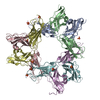
| ||||||||||||||||||||||||
|---|---|---|---|---|---|---|---|---|---|---|---|---|---|---|---|---|---|---|---|---|---|---|---|---|---|
| 1 | 
| ||||||||||||||||||||||||
| 2 | 
| ||||||||||||||||||||||||
| 3 | 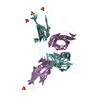
| ||||||||||||||||||||||||
| Unit cell |
| ||||||||||||||||||||||||
| Noncrystallographic symmetry (NCS) | NCS oper:
|
- Components
Components
| #1: Protein | Mass: 23127.775 Da / Num. of mol.: 6 / Fragment: FN3 DOMAINS, RESIDUES 496-598,601-692 / Mutation: YES Source method: isolated from a genetically manipulated source Source: (gene. exp.)  HOMO SAPIENS (human) / Cell line (production host): 293-EBNA / Production host: HOMO SAPIENS (human) / Cell line (production host): 293-EBNA / Production host:  HOMO SAPIENS (human) / References: UniProt: P13591 HOMO SAPIENS (human) / References: UniProt: P13591#2: Chemical | ChemComp-SO4 / #3: Water | ChemComp-HOH / | Compound details | ENGINEERED RESIDUE IN CHAIN A, MET 611 TO ARG ENGINEERED RESIDUE IN CHAIN B, MET 611 TO ARG ...ENGINEERED | Sequence details | N-TERMINAL APLA AND C-TERMINAL AAAHHHHHH ARE VECTOR- DERIVED. QG (POSITIONS 599-600) OF P13591 ...N-TERMINAL APLA AND C-TERMINAL AAAHHHHHH ARE VECTOR- DERIVED. QG (POSITIONS 599-600) OF P13591 REPLACED BY R ( NATURAL MUSCLE- AND BRAIN-SPECIFIC SPLICE VARIANT). M610 REPLACED BY R (DESIGNED MUTATION). | |
|---|
-Experimental details
-Experiment
| Experiment | Method:  X-RAY DIFFRACTION / Number of used crystals: 1 X-RAY DIFFRACTION / Number of used crystals: 1 |
|---|
- Sample preparation
Sample preparation
| Crystal | Density Matthews: 3.06 Å3/Da / Density % sol: 59.48 % / Description: NONE |
|---|---|
| Crystal grow | pH: 4.6 / Details: pH 4.6 |
-Data collection
| Diffraction | Mean temperature: 100 K |
|---|---|
| Diffraction source | Source:  SYNCHROTRON / Site: SYNCHROTRON / Site:  SRS SRS  / Beamline: PX10.1 / Wavelength: 1.12 / Beamline: PX10.1 / Wavelength: 1.12 |
| Detector | Type: MARRESEARCH / Detector: CCD / Date: Jun 21, 2007 |
| Radiation | Protocol: SINGLE WAVELENGTH / Monochromatic (M) / Laue (L): M / Scattering type: x-ray |
| Radiation wavelength | Wavelength: 1.12 Å / Relative weight: 1 |
| Reflection | Resolution: 2.7→20 Å / Num. obs: 44403 / % possible obs: 99 % / Observed criterion σ(I): 0 / Redundancy: 6.2 % / Rmerge(I) obs: 0.08 / Net I/σ(I): 17.9 |
| Reflection shell | Resolution: 2.7→2.85 Å / Redundancy: 5.6 % / Rmerge(I) obs: 0.45 / Mean I/σ(I) obs: 4.3 / % possible all: 97.2 |
- Processing
Processing
| Software |
| ||||||||||||||||||||||||||||||||||||||||||||||||||||||||||||||||||||||||||||||||
|---|---|---|---|---|---|---|---|---|---|---|---|---|---|---|---|---|---|---|---|---|---|---|---|---|---|---|---|---|---|---|---|---|---|---|---|---|---|---|---|---|---|---|---|---|---|---|---|---|---|---|---|---|---|---|---|---|---|---|---|---|---|---|---|---|---|---|---|---|---|---|---|---|---|---|---|---|---|---|---|---|---|
| Refinement | Method to determine structure:  MOLECULAR REPLACEMENT MOLECULAR REPLACEMENTStarting model: NCAM FN3 DOMAIN PAIR, WILD-TYPE Resolution: 2.7→20 Å / Data cutoff high absF: 10000 / Isotropic thermal model: RESTRAINED / Cross valid method: THROUGHOUT / σ(F): 0 / Stereochemistry target values: MAXIMUM LIKELIHOOD
| ||||||||||||||||||||||||||||||||||||||||||||||||||||||||||||||||||||||||||||||||
| Solvent computation | Bsol: 37.8006 Å2 / ksol: 0.4 e/Å3 | ||||||||||||||||||||||||||||||||||||||||||||||||||||||||||||||||||||||||||||||||
| Displacement parameters |
| ||||||||||||||||||||||||||||||||||||||||||||||||||||||||||||||||||||||||||||||||
| Refinement step | Cycle: LAST / Resolution: 2.7→20 Å
| ||||||||||||||||||||||||||||||||||||||||||||||||||||||||||||||||||||||||||||||||
| Refine LS restraints |
|
 Movie
Movie Controller
Controller




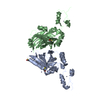
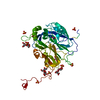




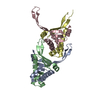

 PDBj
PDBj















